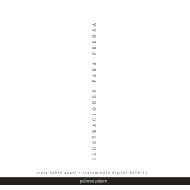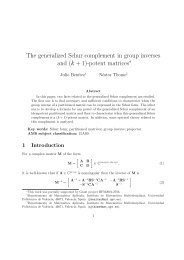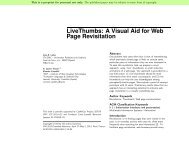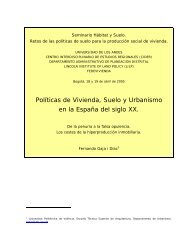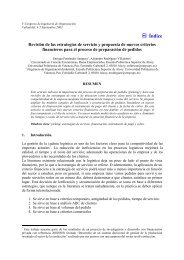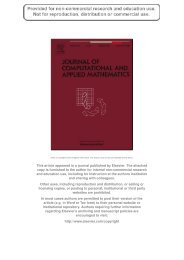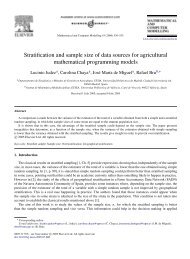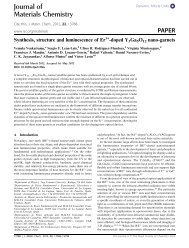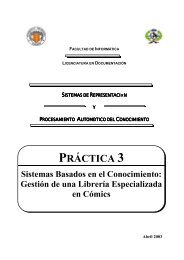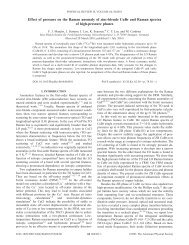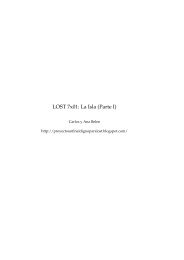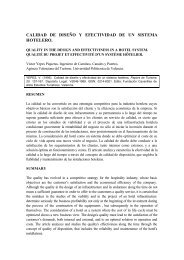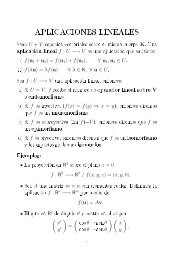Introduction to the resistivity surveying method. The resistivity of ...
Introduction to the resistivity surveying method. The resistivity of ...
Introduction to the resistivity surveying method. The resistivity of ...
Create successful ePaper yourself
Turn your PDF publications into a flip-book with our unique Google optimized e-Paper software.
58<br />
Appendix C<br />
Inversion <strong>method</strong><br />
All inversion <strong>method</strong>s essentially try <strong>to</strong> find model for <strong>the</strong> subsurface whose response agrees<br />
with <strong>the</strong> measured data. In <strong>the</strong> cell-based <strong>method</strong> used by <strong>the</strong> RES2DINV and RES3DINV<br />
programs, <strong>the</strong> model parameters are <strong>the</strong> <strong>resistivity</strong> values <strong>of</strong> <strong>the</strong> model blocks, while <strong>the</strong> data<br />
is <strong>the</strong> measured apparent <strong>resistivity</strong> values. It is well known that for <strong>the</strong> same data set, <strong>the</strong>re is<br />
a wide range <strong>of</strong> models whose calculated apparent <strong>resistivity</strong> values agree with <strong>the</strong> measured<br />
values <strong>to</strong> <strong>the</strong> same degree. Besides trying <strong>to</strong> minimise <strong>the</strong> difference between <strong>the</strong> measured<br />
and calculated apparent <strong>resistivity</strong> values, <strong>the</strong> inversion <strong>method</strong> also attempts <strong>to</strong> reduce o<strong>the</strong>r<br />
quantities that will produce certain desired characteristics in <strong>the</strong> resulting model. <strong>The</strong><br />
additional constrains also help <strong>to</strong> stabilise <strong>the</strong> inversion process. <strong>The</strong> RES2DINV (and<br />
RES3DINV) program uses an iterative <strong>method</strong> whereby starting from an initial model, <strong>the</strong><br />
program tries <strong>to</strong> find an improved model whose calculated apparent <strong>resistivity</strong> values are<br />
closer <strong>to</strong> <strong>the</strong> measured values. One well known iterative inversion <strong>method</strong> is <strong>the</strong> smoothnessconstrained<br />
<strong>method</strong> (deGroot-Hedlin and Constable, 1990) that has <strong>the</strong> following<br />
ma<strong>the</strong>matical form.<br />
(J T J + uF)d = J T g - uFr (C.1)<br />
where<br />
F = a smoothing matrix<br />
J = <strong>the</strong> Jacobian matrix <strong>of</strong> partial derivatives<br />
r = a vec<strong>to</strong>r containing <strong>the</strong> logarithm <strong>of</strong> <strong>the</strong> model <strong>resistivity</strong> values<br />
u = <strong>the</strong> damping fac<strong>to</strong>r<br />
d = model perturbation vec<strong>to</strong>r<br />
g = <strong>the</strong> discrepancy vec<strong>to</strong>r<br />
<strong>The</strong> discrepancy vec<strong>to</strong>r, g, contains <strong>the</strong> difference between <strong>the</strong> calculated and<br />
measured apparent <strong>resistivity</strong> values. <strong>The</strong> magnitude <strong>of</strong> this vec<strong>to</strong>r is frequently given as a<br />
RMS (root-mean-squared) value. This is <strong>the</strong> quantity that <strong>the</strong> inversion <strong>method</strong> seeks <strong>to</strong><br />
reduce in an attempt <strong>to</strong> find a better model after each iteration. <strong>The</strong> model perturbation vec<strong>to</strong>r,<br />
d, is <strong>the</strong> change in <strong>the</strong> model <strong>resistivity</strong> values calculated using <strong>the</strong> above equation which<br />
normally results in an “improved” model. <strong>The</strong> above equation tries <strong>to</strong> minimise a<br />
combination <strong>of</strong> two quantities, <strong>the</strong> difference between <strong>the</strong> calculated and measured apparent<br />
<strong>resistivity</strong> values as well as <strong>the</strong> roughness (i.e. <strong>the</strong> reciprocal <strong>of</strong> <strong>the</strong> model smoothness) <strong>of</strong> <strong>the</strong><br />
model <strong>resistivity</strong> values. <strong>The</strong> damping fac<strong>to</strong>r, u, controls <strong>the</strong> weight given <strong>to</strong> <strong>the</strong> model<br />
smoothness in <strong>the</strong> inversion process. <strong>The</strong> larger <strong>the</strong> damping fac<strong>to</strong>r, <strong>the</strong> smoo<strong>the</strong>r will be <strong>the</strong><br />
model but <strong>the</strong> apparent <strong>resistivity</strong> RMS error will probably be larger.<br />
<strong>The</strong> basic smoothness-constrained <strong>method</strong> as given in equation C.1 can be modified in<br />
several ways that might give better results in some cases. <strong>The</strong> elements <strong>of</strong> <strong>the</strong> smoothing<br />
matrix F can be modified such that vertical (or horizontal) changes in <strong>the</strong> model <strong>resistivity</strong><br />
values are emphasised in <strong>the</strong> resulting model. In <strong>the</strong> above equation, all data points are given<br />
<strong>the</strong> same weight. In some cases, especially for very noisy data with a small number <strong>of</strong> bad<br />
datum points with unusually high or low apparent <strong>resistivity</strong> values, <strong>the</strong> effect <strong>of</strong> <strong>the</strong> bad<br />
points on <strong>the</strong> inversion results can be reduced by using a data weighting matrix.<br />
Equation C.1 also tries <strong>to</strong> minimise <strong>the</strong> square <strong>of</strong> <strong>the</strong> spatial changes, or roughness, <strong>of</strong><br />
<strong>the</strong> model <strong>resistivity</strong> values. This tends <strong>to</strong> produce a model with a smooth variation <strong>of</strong><br />
<strong>resistivity</strong> values. This approach is acceptable if <strong>the</strong> actual subsurface <strong>resistivity</strong> varies in a<br />
smooth and gradational manner. In some cases, <strong>the</strong> subsurface geology consists <strong>of</strong> a number<br />
Copyright (1999-2001) M.H.Loke



